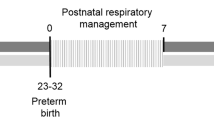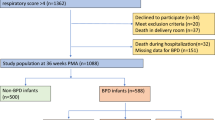Abstract
Objective:
We studied the ante- and postnatal risk factors and clinical outcomes associated with pulmonary interstitial emphysema (PIE) in extremely low birth weight infants (ELBW, <1000 g at birth) in the present era of tocolytics, antenatal steroid and postnatal surfactant administration.
Study design:
This was a retrospective case-controlled study of all ELBW admitted consecutively during a designated study-period in a level III nursery. Data were analyzed by performing univariate and multivariate analysis as applicable.
Results:
Infants with PIE had lower 1 and 5 min Apgar scores (P=0.04 and 0.003 respectively), increased surfactant utilization (P=0.004), higher maximum inspired oxygen concentration (P=0.04) and mean airway pressure administration (P=0.02) during the first week of life, and increased neonatal mortality (P=0.01). They received higher antenatal doses of magnesium sulfate (MgSO4) (P=0.02). 56% of infants with PIE were exposed to more than 10 g of MgSO4 (Mg10), compared to 15% in non-PIE group (P=0.01). The multivariate logistic regression analysis including significant co-variates revealed an independent association between Mg10 and PIE (P=0.01, Odds ratio 19.8, 95% CI 1.5–263).
Conclusion:
Pulmonary interstitial emphysema is associated with increased mortality in ELBW infants. Mg10 is an independent risk factor for PIE in this population.
This is a preview of subscription content, access via your institution
Access options
Subscribe to this journal
Receive 12 print issues and online access
$259.00 per year
only $21.58 per issue
Buy this article
- Purchase on Springer Link
- Instant access to full article PDF
Prices may be subject to local taxes which are calculated during checkout
Similar content being viewed by others
References
Caldwell EJ, Powell RD, Mullooly JP . Interstitial emphysema: a study of physiological factors involved in experimental induction of the lesion. Am Rev Res Dis 1970; 102: 516.
Kraybill EN, Rynyan DK, Bose CL, Khan JH . Risk factors for chronic lung disease in infants with birth weight of 751–1000 gms. J Pediatr 1989; 155: 115.
Verma R . Respiratory distress syndrome of the newborn infant. Obstet Gynecol Rev 1995; 50(7): 542–555.
Gurakan B, Tarkan A, Arda IS, Coskun M . Persistent pulmonary interstitial emphysema in an unventilated neonate. Pediatr Pulmonol 2002; 34(5): 409–411.
Papile LA, Burnstein J, Burnstein R, Koffler H . Incidence and evolution of the subependymal and intraventricular hemorrhage: a study of infants with birth weight less than 1500 gms. J Pediatr 1978; 92: 524–529.
Gyetvai K, Hannah M, Hodnett D, Ohlsson A . Tocolysis for preterm labor: a systematic review. Obstet Gynecol 1999; 94(5): 869–877.
Norwitz ER, Robinson JN, Challis JRG . Current concepts: the control of labor. N Engl J Med 1999; 341: 660–666.
Scudiero R, Khoshnood B, Pryde P, Lee K-S, Wall S, Mittendorf R . Perinatal death and tocolytic magnesium sulphate. Obstet Gynecol 2000; 96(2): 178–182.
Mittendorf R, Covert R, Boman J, Khosneed B, Lee K-S, Seigler M . Is tocolytic magnesium sulphate associated with increased total pediatric mortality. Lancet 1997; 350: 1517–1518.
Mittendorf R, Dambrosia J, Pryde PG, Lee K-S, Ganopoulos JG, Bessinger RE et al. Magnesium sulfate in preterm labor did not prevent adverse infant outcomes and increased infant mortality. Ev Based Obstet Gynecol 2003; 5(2): 62–63.
Mittendorf R, Dambrosia J, Pryde PG, Lee K-S, Gianopoulos JG, Besinger RE et al. Association between the use of antenatal magnesium sulphate in preterm labor and adverse health outcomes in the infants. Am J Obstet Gynaecol 2002; 186(6): 1111–1118.
Landau R, Scott JA, Smiley RM . Magnesium induced vasodilatation in the dorsal hand vein. BJOG 2004; 111(5): 446–451.
Weintraub Z, Solovenchik M, Reichman B, Ritachild A, Waiseman D, Davkin O et al. Effects of maternal tocolysis on the incidence of severe periventricular/intraventricular hemorrhage in very low birth weight infants. Arch Dis Child Fet Neo Ed 2001; 85(1): F13–F17.
Malaeb SN, Rassi AI, Haddod MC, Seoud MA, Younis KA . Bone mineralization in newborns whose mothers received magnesium sulfate for tocolysis of premature labor. Paedeatr Rad 2004; 34(5): 384–386.
Rantonen T, Kaapa P, Jalonen J, Elkblad U, Peltola O, Valimaki I et al. Antenatal magnesium sulfate exposure is associated with prolonged parathyroid hormone suppression in preterm neonates. Acta Paedeatr 2001; 90(3): 278–281.
Crowther CA, Hiller JE, Doyle LW, Halam RR . Effects of magnesium sulfate given for neuroprotection before preterm birth: a randomized controlled trial. JAMA 2003; 290: 2669–2678.
Elimian A, Verma R, Ogburn P, Weincek V, Spitzer A, Quirk JG . Magnesium sulfate and neonatal outcomes of preterm neonates. J Mat-fetal Neo Med 2002; 12: 118–122.
Farkouh LJ, Thorp JA, Jones PG, Clark RH, Knox GE . Antenatal magnesium exposure and neonatal demise. Am J Obstet Gynecol 2001; 185: 869–872.
Canterino JC, Verma UL, Visintainer PF, Figueroa R, Klein SA, Tejani NA . Maternal magnesium sulfate and the development of neonatal periventrivular leucomalacia and intraventricular hemorrhage. Obstet Gynecol 1999; 93(2): 396–402.
Kimberlin DF, Hauth JC, Goldenburgh RL, Bottoms SF, Iams JD, Mercere B et al. The effects of maternal magnesium sulfate treatment on neonatal morbidity in <or=1000 gms infants. Am J Perinatol 1998; 15(11): 635–641.
Grether JK, Hoogstrate J, Selvin S, Nelson KB . Magnesium Sulfate tocolysis and risk of neonatal death. Am J Obstet Gynecol 1998; 178(1 Part 1): 1–6.
Mezad D, Hallak M, Huleihel M, Gortzak-Uzan L, Smolin A, Mazor M . Intravenous magnesium sulfate effects on maternal serum and amniotic fluid cytokines levels in preterm labor patients. Magnes Res 2002; 15(3–4): 247–252.
Crowther CA . Magnesium sulfate for preventing preterm birth in threatened preterm labor. Cochrane Database Syst Rev 2002; (4): CD001060.
Azria E . Magnesium sulfate in obstetrics: current data. J Gynecol Obstet Biol Reprod (Paris) 2004; 33(6 Part 1): 510–517.
Mittendorf R, Pryde PG . An overview of the possible relationship between antenatal pharmacological magnesium and cerebral palsy. J Perinat Med 2000; 28: 286–293.
Hirtz DG, Nelson K . Magnesium sulfate and cerebral palsy in premature infants. Cur Opin Pediatr 1998; 10: 131–137.
Volpe JP . Neurology of the Newborn, 4th edn. WB Saunders Co: Philadelphia, 2001, pp 429–493.
Leviton A, Paneth N, Susser M, Reuss L, Allred EN, Kuban K et al. Maternal receipt of magnesium sulfate does not seem to reduce the risk of neonatal white matter damage. Pediatr 1997; 99: 1–5.
Acknowledgements
This research was supported by General Clinical Research Grant number 5-MO1-RR-10710.
Author information
Authors and Affiliations
Corresponding author
Rights and permissions
About this article
Cite this article
Verma, R., Chandra, S., Niwas, R. et al. Risk factors and clinical outcomes of pulmonary interstitial emphysema in extremely low birth weight infants. J Perinatol 26, 197–200 (2006). https://doi.org/10.1038/sj.jp.7211456
Received:
Revised:
Accepted:
Published:
Issue Date:
DOI: https://doi.org/10.1038/sj.jp.7211456
Keywords
This article is cited by
-
Positional treatment without mechanical ventilation in a very preterm infant with unilateral pulmonary interstitial emphysema: case report and review of the literature
BMC Pediatrics (2019)
-
Risk factors and clinical outcomes of pulmonary interstitial emphysema in extremely low birth weight infants
Journal of Perinatology (2006)
-
Reply to Dr McAdam's letter: pulmonary interstitial emphysema, antenatal magnesium sulfate and mortality in the extremely low birth weight infants
Journal of Perinatology (2006)



